GLP-1 Mimetic Semaglutide Is Effective Across Ejection Fraction in Patients with HFpEF and Obesity: New STEP-HFpEF Analysis
Courtesy of St Luke’s Mid America Heart Institute

Semaglutide 2.4 mg improved symptoms, physical limitations, and exercise capacity in patients with obesity and heart failure (HF) across the spectrum of left ventricular ejection fraction (LVEF), according to a new analysis of participant data from the STEP-HFpEF (Semaglutide Treatment Effect in People with obesity and HFpEF) clinical trial presented during the Heart Failure Society of America (HFSA) Annual Scientific Meeting 2023, October 6-9, 2023, in Cleveland, OH.1
Results from the prespecified analysis of STEP-HFpEF demonstrated that semaglutide, a glucagon-like peptide-1 (GLP-1) mimetic, improved scores on the Kansas City Cardiomyopathy Questionnaire Clinical Summary (KCCQ-CSS) and also led to reductions in body weight and systemic inflammation across LVEF categories in persons with the obesity phenotype of HFpEF.1
The findings, wrote study authors in the Journal of the American College of Cardiology, support “the potential for use of semaglutide in patients with the obesity phenotype of HFpEF regardless of EF.”1 The study was led by renowned cardiologist Mikhail Kosiborod, MD, vice president of research at Saint Luke's Health System, director of cardiometabolic research and codirector of the Haverty Cardiometabolic Center of Excellence at Saint Luke’s Mid America Heart Institute.
Kosiborod and STEP-HFpEF colleagues originally randomly assigned 529 patients to receive either weekly injections of semaglutide 2.4 mg (n=263) or a placebo injection (n=266) and followed the cohort for 52 weeks.2 At baseline, the cohort had a median body mass index (BMI) of 37 kg/m2 and 66% had a BMI of 35 kg/m2 or greater.2
The study’s dual primary endpoints were defined as change in KCCQ-CSS and in percentage body weight from baseline to 52 weeks.2 A range of secondary endpoints were also specified and included change in 6-minute walk distance (6MWD), change in C-reactive protein (CRP) level, and a hierarchical composite end point that included death, HF events, and differences in change in KCCQ-CSS score and 6MWD test.2

For the current prespecified analysis, and colleagues assessed the effects of semaglutide in the original participants across baseline LVEF strata: 45-49%, 50-59%, and 60% or greater.1 Among the 529-participant cohort, the researchers reported 85 had an LVEF of 45-40%, 215 of 50-59%, and 229 of 60% or greater.1
FINDINGS1
At 52 weeks, the investigators reported similar improvement with weekly semaglutide vs placebo in the dual primary study endpoints across EF strata, as follows.
KCCQ-CSS score (estimated treatment difference [95%CI] (P interaction = .56):
- EF 45-49%: 5.0 points (-2.7 to 12.8)
- EF 50-59%: 9.8 points (5.0 to 14.6)
- EF ≥60%: 7.4 points (2.8 to 12.0)
Change in body weight (estimated treatment difference [95%CI] (P interaction = .08):
- EF 45-49%: -7.6 points (-10.7 to -4.4)
- EF EF50-59%: -10.6 points (-12.6 to -8.6)
- EF: ≥60%: -11.9 points (-13.8 to -9.9)
Similarly, investigators observed no influence by LVEF stratum on key secondary endpoints: 6MWD (P for interaction = .19), hierarchal composite endpoint (P for interaction=.43), C-reactive protein (P for interaction = 0.26), or on the exploratory endpoint of NT-proBNP (P for interaction = 0.96).1

In an accompanying editorial,3 Muthiah Vaduganathan, MD, MPH, and John Ostrominski, MD, applauded their colleagues’ work, noting that evaluations of major medication classes used in the treatment of HF (eg, beta-blockers, renin-angiotensin system inhibitors, angiotensin receptor-neprilysin inhibitors, and mineralocorticoid receptor antagonists) have shown attenuated effect at higher levels of LVEF.3 Semaglutide, on the other hand, demonstrated consistent treatment effects across an LVEF range of 45% and higher.3
Moreover, wrote the study authors in JACC,1 STEP-HFpEF included only participants with the obesity phenotype of HFpEF and so had greater symptom burden and physical limitations compared with other recent HFpEF trials of SGLT2 inhibitors and sacubitril valsartan.1 Improvement across primary and secondary endpoints was considerably greater in STEP-HFpEF than in those studies, they said.1
“Given that the majority of patients with ‘true’ HFpEF have a cardiometabolic phenotype, with very high prevalence of overweight or obesity, it is likely that the treatment approach in this patient population may ultimately include combination therapy with SGLT2 inhibitors and GLP-1 receptor agonists, given their non-overlapping and complementary mechanisms of action,” the researchers concluded.1
References
1. Butler J, Abildstrøm SZ, Borlaug BA. Semaglutide effects according to ejection fraction heart failure with preserved ejection fraction and obesity. J Am Coll Cardiol. Published online October 8, 2023. doi:10.1016/j.jacc.2023.09.811
2. Kosiborod MN, Abildstrøm SZ, Borlaug BA, et al. Semaglutide in patient with heart failure with preserved ejection fraction and obesity. N Engl J Med. Published online August 25, 2023. doi:10.1056/NEJMoa2306963
3. Vaduganathan M, Ostrominski J. Glucagon-like peptide-1 receptor agonists in heart failure: STEPping across the ejection fraction divide. J Am Coll Cardiol. Published online October 8, 2023. doi:10.1016/j.jacc.2023.09.812